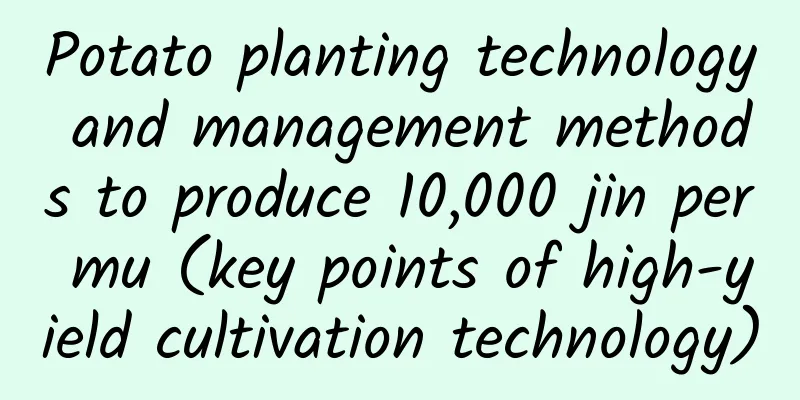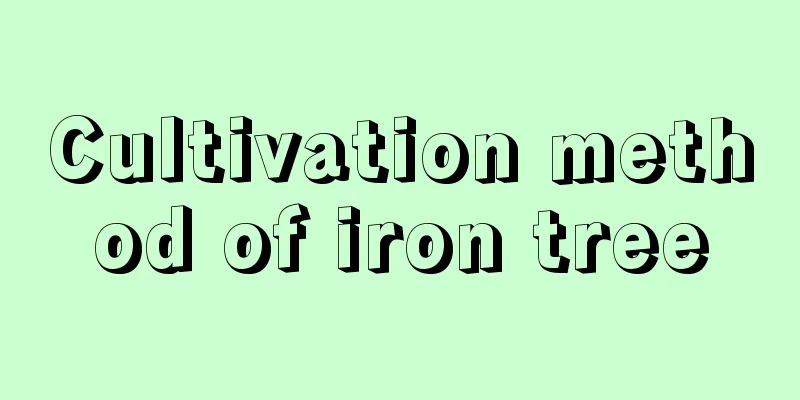Potato planting technology and management methods to produce 10,000 jin per mu (key points of high-yield cultivation technology)

|
After the Rain Water solar term, farmers in Shandong, Hebei, Henan, Shanxi and other areas will begin to prepare for potato planting, and spring potatoes will be planted from the end of March to April. Today I’m sharing some high-yield potato planting and management tips for farmers’ reference. I suggest you save them! 1. If you want to produce more than 10,000 catties per mu, cutting is also a technical jobWhen planting potatoes, we all face the problem of cutting. This is definitely a technical job that can affect the later yield. When many farmers cut potatoes into large pieces, the buds are left in the middle of the potato. In fact, this way of cutting is not quite correct. Normally, one kilogram of potatoes can be cut into 40-50 pieces. It is best to control the weight of each "seed potato" to about 30 grams. In addition, each potato piece should have a bud. In addition, the potatoes should not be cut too thin, and the rotten pieces should be cleaned out to avoid affecting later sowing. The best buds to leave on the potato tubers are the top buds and side buds. Based on the planting experience over the years, it is best not to choose potato tubers with tail buds, as the yield will be about 20% lower than planting potato tubers with top buds and side buds. Second, fertilizer is the guarantee of high yield. One potato weighs more than 1 jin.Over the years, I have come into contact with many large potato growers and learned some fertilizer application skills. Before land preparation, they usually spread about 5 cubic meters of farmyard manure and 50 kilograms of potash fertilizer per mu. Apply 5 kg of urea per mu of soil 2-3 days before the initial watering of sweet potato seedlings, and then water once with a small amount. When the potatoes have finished flowering and the underground rhizomes have grown to the size of eggs, they should also be watered 1-2 times. About 15 days before harvest, potassium dihydrogen phosphate and urea should be sprayed. As for the dosage, 0.5% urea + 0.3% potassium dihydrogen phosphate is recommended, which is conducive to the complete expansion of the tubers. In addition, is it better to use potassium chloride or potassium sulfate for potatoes? Some farmers also have questions in this regard. First of all, it is generally agreed that potatoes are chlorine-sensitive crops and cannot use chlorine-containing fertilizers. However, as we growers know, potatoes have a very high demand for potash fertilizers. If potassium sulfate is used, the price will be very expensive. This year's price is around 4,200-4,400 yuan per ton. However, potassium chloride fertilizer is also very expensive this year. The price of red potassium and white potassium with 60% content at the port has reached 4,300 yuan/ton, which is more than 800 yuan higher per ton than last year. There is no doubt that the planting cost has increased a lot. However, after years of experience and communication with some technicians, it is known that potatoes have an indispensable demand for chlorine throughout their growth period. In fact, even if we use excessive amounts of fertilizers containing chlorine, the potato roots will not absorb all of it, and poisoning and yellowing of leaves will not occur. Therefore, I personally think that if potatoes want to achieve high yields, potassium chloride can be used, and in normal years, it can also reduce costs. However, the price of potassium chloride and potassium sulfate is quite different this year, so choosing one will not have a big impact on the planting cost. 3. What is the appropriate planting depth for potatoes?We know that if potatoes are planted too shallowly, they will have green heads, which will affect their marketability. When ordinary people see such potatoes, their desire to buy them will be greatly reduced. In addition, if the potatoes are planted too shallowly, the root system will have a reduced ability to absorb water and fertilizer, which will directly affect the yield. Through these years of planting, if the potatoes want to have no "green heads" and have a high yield, it is recommended that the planting depth be around 10 centimeters, which is more reasonable. There is one thing we need to pay special attention to. Half a month before sowing potatoes, it is best to soak the potato tubers in gibberellin, and the standard mixture is 100 mg of gibberellic acid to 1 liter of water. After soaking for two hours, dry it in a cool place and then germinate it. The purpose of this is to reduce the occurrence of some diseases and to cultivate strong seedlings. The seedlings will grow well. After we do this, the yield will increase by at least 30%. Interested families may try it on a small area . 4. Why do potatoes only grow vines but not produce potatoes?Many farmers are very confused. Why do my potatoes not produce potatoes when they grow very well in the early stage? When digging potatoes, they find that the potatoes are either too small or the yield is very low. The main problems are the following four aspects: 1. Sowing timeIn areas like Shandong, Henan and Hebei, we can grow two crops of potatoes a year. Spring potatoes are usually planted in late March or early April. If we sow too late, we can calculate the time ourselves, and the expansion period will be when the weather is hot. When potatoes encounter high temperatures, the expansion rate will be reduced, and they will even stop growing when it is particularly hot. In this way, when our sweet potatoes reach the harvest period, a large proportion of them are small. Therefore, it is recommended that farmers move the sowing period of potatoes to March, which will greatly help the yield. 2. The depth of soil cultivation is not enoughPotatoes need to be covered with soil, otherwise, if they are exposed to the sun, the skin of the potatoes will turn green. Therefore, we need to increase the depth, which can also make the soil looser and conducive to the expansion of the tubers. As long as the potato seedlings grow, we can start to cover the soil. The depth should not be less than ten centimeters to reduce the situation of "green heads". 3. No potassium dihydrogen phosphate was sprayed before floweringMy personal suggestion is that farmers should spray 50g of potassium dihydrogen phosphate + 5g of brassinolide + 20-25g of boron + 15kg of water before potatoes bloom. Boron should be chelated as it is not easy to react with potassium dihydrogen phosphate. This is very helpful for potato enlargement and final yield. 4. No nitrogen fertilizer can be applied during the expansion periodWhen potatoes reach the peak flowering stage, which is the swelling stage, you can no longer use nitrogen fertilizer. Instead, you should increase the use of phosphorus fertilizer and potassium fertilizer, which will help increase the swelling of tubers and yield. In addition, the temperature is relatively high in the late stage of potato production, and the fields are airtight. Therefore, we need to improve the potato's ability to resist high temperatures at this time. Yes, you can spray potassium dihydrogen phosphate + triacontanol to enhance its ability to resist high temperatures. |
<<: Can urea plus salt kill weeds? (What mixture of urea can be used as a herbicide?)
Recommend
How to grow Dendrobium
1. Temperature The temperature suitable for the g...
How to grow mung beans
1. Land preparation and fertilization The seedbed...
The role of Xiandan flower
The ornamental value of Ixora The iris is native ...
How to make Clivia bloom quickly?
1. Pruning Sometimes some of the basic leaves are...
Plant a pot of "celery" on the balcony, harvest it when it grows up, and you can’t finish eating it all!
A few days ago, when Huahua was shopping in the m...
How to propagate mint by cuttings
1. Cutting method 1. Select branches: Cut 8-15cm ...
Which month is the best to plant green beans?
Dry-fried green beans are popular for their uniqu...
What kind of soil is good for longevity flowers
1. Sandy soil Sandy soil has very good air permea...
Three key points after flower seeds emerge
Light after seed germination After the flowers ar...
What vegetables are suitable to grow in June?
What vegetables are suitable to grow in June? The...
The flower language and value of lucky grass
Flower Language There are many interpretations ab...
What flowers are suitable for growing in Yangzhou? What are the city flowers and trees?
1. Climate characteristics of Yangzhou Yangzhou b...
Can black beans be grown in the soil?
Can black beans be planted in the soil? Black bea...
Have you watered the Jade Plant thoroughly? What should I do if I watered it too much?
1. Is the watering thorough? When watering the Ja...
What are the hot vegetables?
1. Color If the surface of the vegetable is green...









